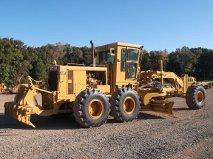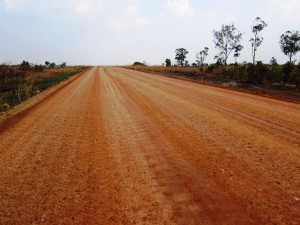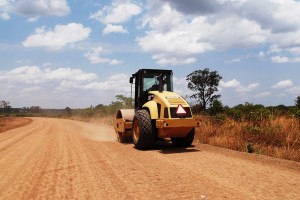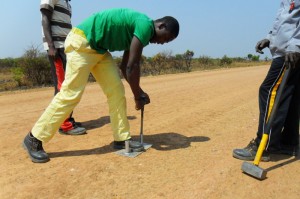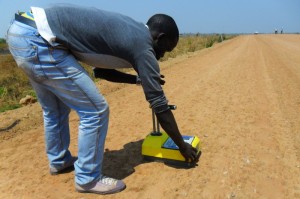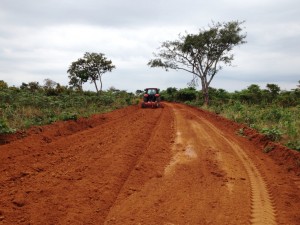How to use it
After you have finished and passed your soil tests, you can start to prepare the road.
First of all you have to assure that you shape the road layer for layer, so that the surface is solid and even. You can shape the road best with a grader. The shaped layers need to be harrowed to the specific depth (often you see that the grader also has a ‘harrow’ on the back side) before you water the road, with the mix of water and Road Rapid. In practice the watering and harrowing needs to be done in several sessions, to reach the best mix and the Optimal Moisture Content (OMC) of the soil. It is good to also divide the amount of Road Rapid necessary for the mixing of the soil over these sessions (for instance if you mix it in two sessions, than use 60% of the amount of Road Rapid for the first water bowser session and the last 40% for the second session, this to reach the optimal mix).
When the soil is brought to the OMC and Road Rapid is mixed well with the soil, the road needs to be compacted with a road roller. This usually takes place in several sessions to achieve the maximum dry density and come to the optimal result.
Make sure that there is a slope / gradient in the road. Where the sides of the road start at 0cm the middle of the road should be about 6 to 7 cm of height. This secures you from dewatering instead of water staying on the road. Over time the road will further compact by the traffic on it, it will further hard out till about 5 months after the road is paved.
To emphasize this: it is necessary to make sure that the shape of the road, the mixing and stabilizing is done well to benefit optimal from Road Rapid. Please keep in mind that as a consequence of reaching the OMC you cannot pave the road during the rainy season.
An advantage is that you can directly start using the road once its paved, as it starts hardening immediately. Opening the road directly is actually very advisable to do, because through the traffic you will further compact the road. So it will automatically get stronger.
Besides of hardening the road, you also have an additional benefit: the future maintenance costs will drop significantly. You don’t have to renew and repair the roads after the rainy season and everybody knows that road maintenance costs bear a heavy load on a Government’s infrastructure budget.
But should there be any maintenance(because the road was not correctly paved or not mixed well at a certain point), you can just repair that part by reusing the top layer; shred it and add fresh soil to it and then repeat the process as described before. The already used top layer will be used as a filler for the construction.
To give you an idea about the Road Rapid quantities you require, you will find an overview in the table below:
| Road Rapid | ||
| Clay content | Dosage in litres per m³ | Depth in mm |
| 15-20 % | 0.25 | 150 |
| 20-30% | 0.30 | 150 |
| 30-45% | 0.40 | 150 |
| 45>% | 0.45 | 150 |
As you see you only need a very small quantity to create a good quality and sustainable road.
Read more:
Introduction
Type of soil
The testing phase
